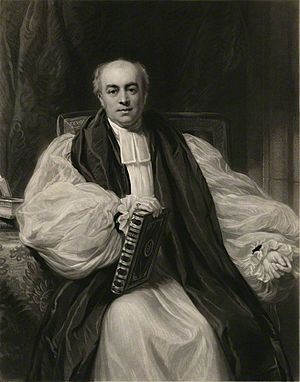Samuel Butler (schoolmaster) facts for kids
Quick facts for kids The Right Reverend Samuel Butler FRS |
|
|---|---|
| Bishop of Lichfield | |
 |
|
| Diocese | Diocese of Lichfield |
| In Office | 1836–1839 |
| Predecessor | Henry Ryder |
| Successor | James Bowstead |
| Personal details | |
| Born | 30 January 1774 |
| Died | 4 December 1839 (aged 65) |
| Nationality | British |
| Denomination | Anglican |
| Education | Rugby School |
| Alma mater | St John's College, Cambridge |
Samuel Butler (born January 30, 1774 – died December 4, 1839) was an important English classical scholar. He was also a schoolmaster at Shrewsbury School and later became a Bishop of Lichfield. You might know his grandson, also named Samuel Butler, who was a famous writer. He wrote the novel Erewhon.
Contents
Early Life and Education
Samuel Butler was born in Kenilworth, a town in Warwickshire, England. He went to Rugby School for his early education. In 1791, he started studying at St John's College, Cambridge, which is a famous university.
While at Cambridge, Samuel was very good at his studies. He won several awards for his writing in Latin and Greek. In 1793, he won the Craven scholarship, which is a special award for top students. One of the students he competed against was Samuel Taylor Coleridge, a well-known poet. Samuel Butler earned his first degree in 1796 and became a Doctor of Divinity in 1811.
Becoming a Headmaster and Clergyman
In 1797, Samuel Butler became a fellow at St John's College. He also became a deacon in the Church of England, which is a step towards becoming a priest. The very next year, in 1798, he became the headmaster of Shrewsbury School. He was only 24 years old at the time. In the same year, he was also ordained as a priest.
Besides his work as a headmaster, Samuel Butler held several church positions. He was a vicar in Kenilworth and had other roles in Lichfield Cathedral. In 1836, he was promoted to the important position of Bishop of Lichfield.
Leading Shrewsbury School
Samuel Butler is best remembered for his time as headmaster of Shrewsbury School. During his leadership, the school became very famous. Its academic standards were considered among the best in England. He helped create a system where older students, called "Praepostors," had some authority over younger students.
However, school life wasn't always easy for the students. There were often many fights between boys, which Dr. Butler seemed to ignore. The living conditions for students who boarded at the school were not very comfortable. There were also many complaints about the food. One time, this even led to a student riot. Some people even joked that his initials "S.B." on the school gate stood for "stale bread, sour beer, salt butter, and stinking beef." He also tried to stop students from playing football, saying it was "only fit for butcher boys."
Famous Students
Many notable people studied under Samuel Butler at Shrewsbury School. One of his most famous pupils was Charles Darwin, who later developed the theory of evolution. Darwin remembered that he disliked the way things were taught, especially learning by heart. Another important student was Benjamin Hall Kennedy, who later became the headmaster of Shrewsbury School after Butler.
His Writings and Collections
Samuel Butler was also a scholar. He published an edition of the works of Aeschylus, an ancient Greek writer. He also wrote a book called Sketch of Modern and Ancient Geography in 1813, which was used in schools. He also created atlases, which are collections of maps.
He had a very large library. It included many rare books printed by the Aldine Press and valuable Greek and Latin manuscripts.
Later Life and Legacy
When Samuel Butler became a bishop, his health was not good. He suffered from asthma. He passed away in December 1839 at the age of 65. He is buried in the churchyard of St Mary's Church, Shrewsbury.
After his death, his valuable collection of books was sold. The manuscripts were bought by the British Museum. In his will, he left a large house and land in Shrewsbury to his grandson, Samuel Butler the novelist. Later, when his grandson developed the land for new houses, he named one of the streets "Bishop Street" to honor his grandfather.

